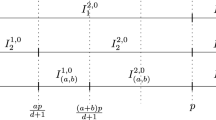Abstract
We study the so-called frog model: Initially there are some “sleeping” particles and one “active” particle. A sleeping particle is activated when an active particle hits it, after that the activated particle starts to walk independently of everything and can activate other sleeping particles as well. The initial configuration of sleeping particles is random with density p(x). We identify the critical rate of decay of p(x) separating transience from recurrence, and study some other properties of the model.
Similar content being viewed by others
REFERENCES
F. Comets, M. V. Menshikov, and S. Yu. Popov, Lyapunov functions for random walks and strings in random environment, Ann. Probab. 26(4):1433-1445 (1998).
F. Comets, M. V. Menshikov, and S. Yu. Popov, One-dimensional branching random walk in random environment: A classification, Markov Processes Relat. Fields 4(4):465-477 (1998).
G. R. Grimmett, M. V. Menshikov, and S. E. Volkov, Random walks in random labyrinths, Markov Processes Relat. Fields 2(1):69-86 (1996).
F. den Hollander, M. V. Menshikov, and S. Yu. Popov, A note on transience versus recurrence for a branching random walk in random environment, J. Statist. Phys. 95(3/4):587-614 (1999).
F. den Hollander, M. V. Menshikov, and S. E. Volkov, Two problems about random walks in a random field of traps, Markov Processes Relat. Fields 1(2):185-202 (1995).
Y. Hu and Z. Shi, The limits of Sinai's simple random walk in random environment, Ann. Probab. 26(4):1477-1521 (1998).
G. F. Lawler, Intersections of Random Walks (Birkhäuser, Boston, 1991).
M. V. Menshikov and S. E. Volkov, Branching Markov chains: Qualitative characteristics, Markov Processes Relat. Fields 3(2):225-241 (1997).
R. Pemantle and Y. Peres, Critical random walk in random environment on trees, Ann. Probab. 23(1):105-140 (1995).
F. Solomon, Random walks in a random environment, Ann. Probab. 3(1):1-31 (1975).
F. Spitzer, Principles of Random Walk, 2nd ed. (Springer, New York, 1976).
Author information
Authors and Affiliations
Rights and permissions
About this article
Cite this article
Popov, S.Y. Frogs in Random Environment. Journal of Statistical Physics 102, 191–201 (2001). https://doi.org/10.1023/A:1026516826875
Issue Date:
DOI: https://doi.org/10.1023/A:1026516826875




